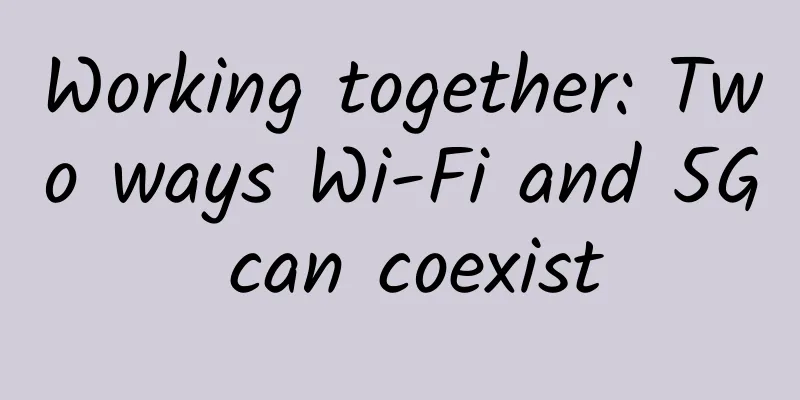Working together: Two ways Wi-Fi and 5G can coexist

|
WBA: Wi-Fi and 5G coexist at the physical layer of the network to provide a " better connection" experience
Bruno Tomas, director of the Wireless Broadband Alliance (WBA), told RCR Wireless News that currently the only way for Wi-Fi and 5G to work together is to coexist. “Today, you don’t have convergence,” he said. “Technically, you can’t say you’re deploying a converged Wi-Fi and 5G network, or even Wi-Fi and LTE. You only have coexistence.” He went on to explain that from a WBA perspective, there are two ways to think about how Wi-Fi and 5G can coexist: coexistence at the network physical layer and what Tomas calls “excellent connectivity” coexistence. Each scenario presents its own challenges. Physical layer coexistence: The first way to think about Wi-Fi and 5G coexistence on a network is to physically use the technologies in both bands. The key here is that each technology must "play well together" and effectively avoid interfering with each other. “For example, when you use 5G NR-U,” Tomas explained, “you’re using the exact same frequency band that Wi-Fi has been using for years. First, they’re going to be in the 6 GHz band, so the 3GPP specifications already include ways for 5G to operate completely independently in this unlicensed band, and there have to be coexistence metrics so that there’s no harmful interference between the two technologies.” To aid this type of coexistence, the WBA is working to develop automated frequency systems and threshold levels for each technology. “At an industry level, we need to reach consensus on these systems and thresholds,” Tomas said. After all, this isn’t all that different from how Wi-Fi and 4G currently coexist, each supporting different use cases. The difference is that Wi-Fi 6 might not be used for cellular offload in large venues or stadiums, as is common today, but could be used for other parts of the venue network, as well as other applications. Excellent connection coexistence: The second approach to achieving coexistence is to focus on developing a method to ensure that when Wi-Fi and cellular connections exist simultaneously, users are always connected to the technology that provides the best , most reliable coverage. We've all been there before: sitting in a coffee shop, or even at home, toggling the Wi-Fi button on and off, trying to figure out which is faster, cellular or Wi-Fi. Tomas sidestepped the conundrum by asking, “If I have overlapping Wi-Fi and 5G coverage or overlapping Wi-Fi and private LTE coverage, where do I connect? If I’m connected to cellular and I go into a venue, what are the good metrics for me to switch and still maintain quality of service and stay consistent with my subscription plan?” In a 5G world, this coexistence and the resulting barriers for users will continue to exist, especially in large venues. The WBA hopes its Wi-Fi Open Roaming service can ease this challenge by automatically letting user devices decide which network to connect to for the best coverage. Tomas explained that the OpenRoaming system allows connectivity providers to go from allowing users’ devices to automatically connect to Wi-Fi networks with downlinks below 5 Mbps to keeping them on cellular networks. |
<<: How to use gdb to accurately locate deadlock problems in multithreading
>>: Several emerging trends in the SD-WAN space
Recommend
With spending of the three major operators declining, has China's 5G construction slowed down?
In 2020, China's 5G network construction deve...
With spectrum deployment and commercialization accelerating, how far is it from 5G clearance?
On June 15, 2017, the global 5G entered a critica...
ColoCrossing new bare metal cloud: $20/month-4 cores/8GB/120G SSD/20TB@1Gbps
ColoCrossing recently launched the Bare Metal Clo...
The three major US telecom giants spent huge sums of money to buy a new batch of 5G spectrum
According to foreign media, according to the late...
UUUVPS Promotion: Hong Kong CN2 line VPS annual payment starts from 89 yuan, US San Jose CN2 line VPS annual payment starts from 99 yuan
UUUVPS (Sanyou Cloud)'s 3rd anniversary promo...
10 Things You Need to Know About Cisco Global Gold Certification
Welcome to Cisco Global Gold! For the first time ...
Nginx log analysis: writing shell scripts for comprehensive log statistics
Nginx is a high-performance HTTP and reverse prox...
Operators hijacked the system and even changed Json
Operator hijacking is a common tactic used by thi...
Megalayer: San Jose CN2 line VPS monthly payment starts from 48 yuan, Hong Kong VPS monthly payment starts from 59 yuan
The tribe once shared information about Megalayer...
Five API Gateway Technology Options
This article intends to discuss gateways around s...
Inner Mongolia promotes "Internet +" and explores government cloud construction
[[188588]] The intensive construction of "In...
Building the future of intelligent networks at the edge
Edge computing is evolving and is the future of b...
20% off on all Ouluyun VPS, starting from $3.2/month for Los Angeles CN2 GIA/Hong Kong CN2 GIA lines
EuroCloud was established in 2021 and registered ...
F5 Named a Leader in WAF by Independent Research Firm Forrester Research
F5 Networks (NASDAQ: FFIV) today announced that i...
What are the differences between the 8 modes of 5G independent networking and non-independent networking?
5G is the fifth generation of communication techn...








![[Double Holiday] Megalayer Hong Kong CN2 server 399 yuan/month, Hong Kong/US high-end VPS/8 cores, 16G memory, 240G SSD, 3IP, starting from 199 yuan/month](/upload/images/67cabc7f2ce1c.webp)
